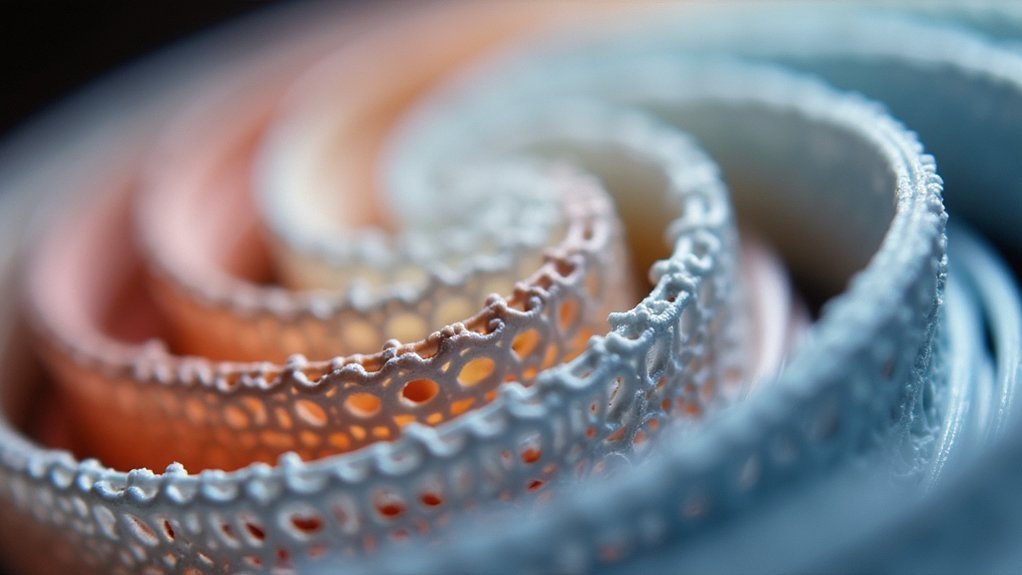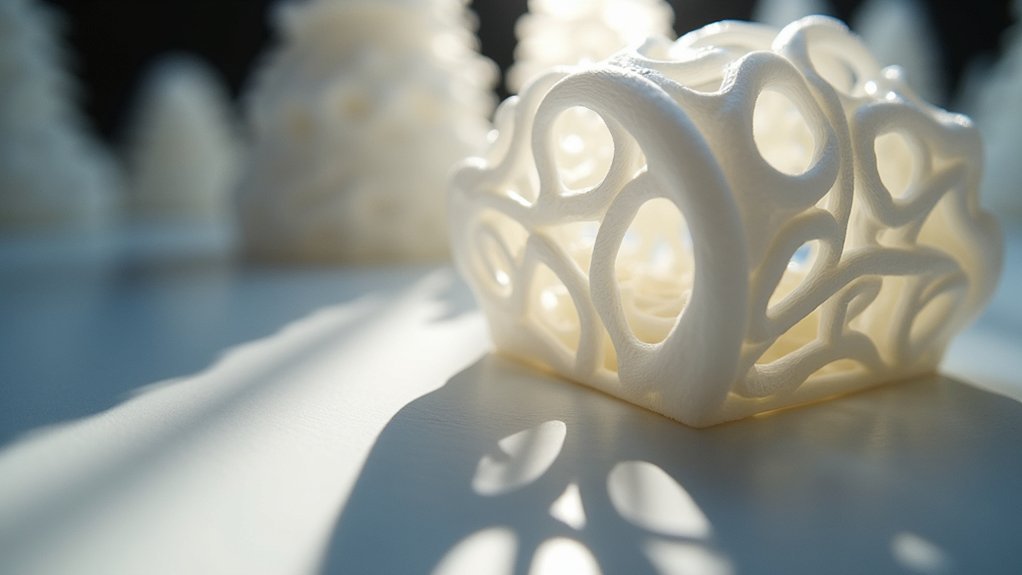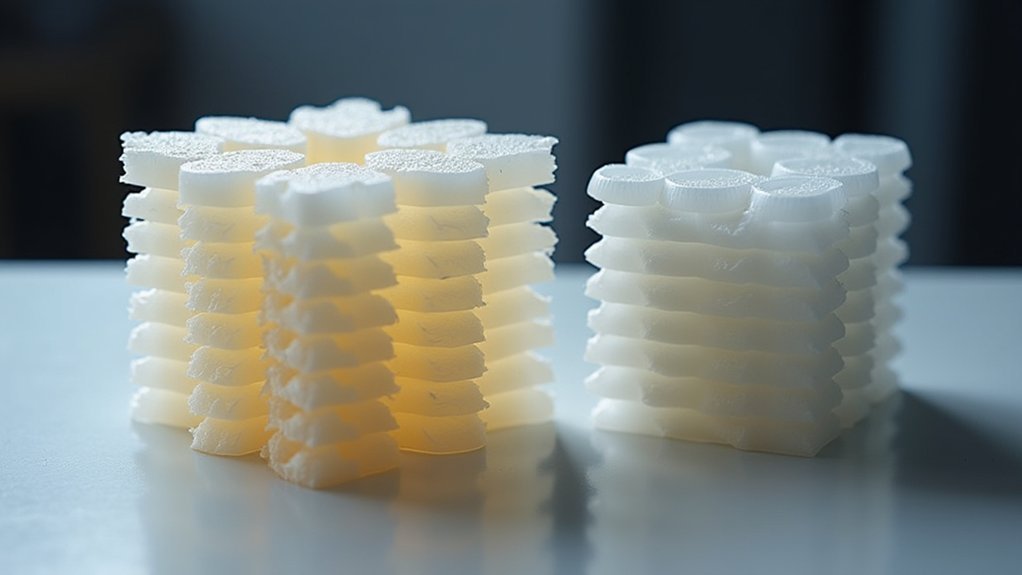You’ll find gyroid infill offers exceptional strength-to-weight performance, delivering up to 10 times steel’s strength while maintaining structural integrity at just 10% density. Its triply periodic minimal surface provides near-isotropic properties and superior shear strength compared to traditional patterns. However, you’ll face longer slicing times, increased printer vibrations, and potential compatibility issues with some software. The intricate geometry also creates risks of filament jams and inconsistent extrusion that require careful consideration for your specific applications.
What Is Gyroid Infill and Its Unique Characteristics

When you’re exploring advanced 3D printing techniques, gyroid infill stands out as one of the most sophisticated internal structures available.
This gyroid infill pattern utilizes a triply periodic minimal surface structure, originally discovered by physicist Alan Schoen in 1970. Its unique geometry consists of intricate, interlocking wavy lines that create robust three-dimensional formations.
You’ll find that gyroid infill delivers excellent strength and superior shear resistance across all directions, providing near-isotropic strength properties. This means your prints maintain consistent structural strength regardless of stress direction.
The pattern optimizes material usage remarkably well—you can adjust infill density to as low as 10% while still achieving impressive performance.
Beyond functionality, the visually striking internal architecture adds aesthetic appeal to decorative prints where the structure remains visible.
Key Advantages of Gyroid Infill Pattern
Building upon these remarkable characteristics, gyroid infill offers several compelling advantages that make it a top choice for advanced 3D printing applications.
Gyroid infill delivers unmatched strength-to-weight performance, making it the premier choice for cutting-edge 3D printing projects.
You’ll achieve an exceptional strength-to-weight ratio that can reach up to 10 times greater than steel while maintaining only 5% density with advanced materials. The optimized material usage considerably reduces your filament consumption and printing costs through its interlocking geometry.
You can maintain structural integrity even at low densities, requiring as little as 10% infill for sufficient strength in lightweight components. The continuous wavy structure distributes stresses evenly, minimizing warping issues.
Additionally, you’ll benefit from excellent heat dissipation through interconnected channels, improving cooling during printing and enhancing overall quality.
Notable Disadvantages and Limitations

While gyroid infill offers impressive benefits, you’ll encounter several notable drawbacks that could impact your 3D printing workflow.
You’ll face considerably longer slicing times due to the pattern’s mathematical complexity, which can overwhelm less powerful computers during G-code generation.
Additionally, you’ll need to manage increased printer vibrations from the continuous wavy motions and work around limited software compatibility since not all slicers support this advanced infill type.
Extended Slicing Processing Time
Although gyroid infill offers superior strength-to-weight ratios, its complex mathematical geometry greatly increases slicing processing time compared to simpler patterns like grid or rectilinear infill.
You’ll notice extended slicing time when your computer performs intricate calculations required for gyroid structures. This longer slicing process demands significant processing power, particularly challenging less powerful systems that may experience slowdowns or software crashes due to increased memory usage.
You’ll face considerable delays in generating G-code, extending your print preparation wait time substantially.
These processing bottlenecks directly impact project timelines, making gyroid infill impractical for rapid prototyping applications requiring quick turnaround. If you’re working on time-sensitive projects or using lower-end hardware, you should consider whether gyroid’s benefits outweigh these processing limitations.
Printer Vibration Issues
Beyond slicing complications, gyroid infill creates considerable vibration problems that can compromise your print quality. The complex geometry generates excessive printer vibrations, especially at high infill density levels.
These vibrations amplify resonances throughout your machine, causing layer misalignment and visible defects in your finished parts.
If you’re using a less robust printer that isn’t properly calibrated, gyroid infill will strain your mechanics considerably. The continuous wavy structure intensifies these issues, potentially leading to filament jams and inconsistent extrusion during printing.
You’ll need to reduce your print speed and carefully adjust acceleration settings to minimize these problems.
Without a well-calibrated printer and optimized settings, gyroid infill’s vibration issues can considerably outweigh its structural benefits.
Limited Software Compatibility
When you’re ready to implement gyroid infill, you’ll quickly discover that not all slicer software supports this advanced pattern. Limited compatibility restricts your options, forcing you to choose between your preferred slicer and gyroid’s benefits.
| Challenge | Impact |
|---|---|
| Complex calculations | Longer slicing times |
| Intricate geometry | Print reliability issues |
| Plugin requirements | Extended preparation time |
Even compatible slicers often require specific settings or plugins, complicating your user experience. The software must optimize handling of gyroid’s mathematical complexity, and many programs simply aren’t equipped for this task. You’ll face increased preparation time as your slicer struggles with the intricate geometry calculations. This limitation makes gyroid less appealing if you need straightforward solutions or rely on basic slicer software for your workflow.
Strength and Performance Comparison

Since gyroid infill’s unique mathematical structure creates a near-isotropic strength distribution, you’ll find it delivers robust resistance to forces in both vertical and horizontal directions.
This performance advantage becomes evident when comparing gyroid infill to traditional grid and triangle patterns – you’ll achieve superior shear strength while maintaining lightweight characteristics.
The infill density directly impacts your print’s structural integrity, yet gyroid maintains sufficient strength even at low densities around 10%.
While infill density determines structural performance, gyroid delivers exceptional strength at minimal 10% densities, maximizing efficiency without compromising integrity.
This efficient material usage means you’re getting maximum performance without excess weight. When using advanced materials like graphene, gyroid structures can reach strength levels up to 10 times greater than steel while retaining only 5% density.
The interlocking geometry distributes stresses evenly, reducing warping risks and ensuring consistent durability across your printed objects.
Material Efficiency and Cost Considerations
Gyroid infill’s exceptional strength characteristics translate directly into considerable cost savings through reduced material consumption.
You’ll achieve remarkable material efficiency with gyroid infill, as its optimized geometry minimizes filament consumption while maintaining structural integrity. When cost considerations matter most, this pattern delivers outstanding value by reducing overall production costs, especially with expensive materials like graphene.
You can adjust infill density down to 10% without sacrificing strength, making it perfect for weight-critical applications.
The superior strength-to-weight ratio means you’ll use considerably less filament compared to traditional solid patterns while achieving comparable durability.
This balance between minimal material usage and robust performance makes gyroid infill an ideal choice for both functional prototypes and artistic projects where budget efficiency is paramount.
Optimal Applications and Use Cases
Because of its unique structural properties and material efficiency, gyroid infill excels in specific applications where traditional patterns fall short.
You’ll find this interlocking lattice structure delivers exceptional strength while maintaining ideal weight distribution across various industries.
Here’s where gyroid infill truly shines:
- Aerospace and automotive applications – Perfect for lightweight structures that require maximum strength-to-weight ratios without sacrificing performance
- Electronics and energy systems – Superior heat dissipation through interconnected channels keeps components cool and efficient
- Functional prototypes – Maintains structural integrity even at low densities, making testing and development cost-effective
- Aesthetic designs – Combines visual appeal with functional strength for decorative items and architectural elements
You’re getting both form and function when choosing gyroid infill for these specialized applications.
Implementation Tips for Best Results
You’ll need to optimize your slicer software settings to access gyroid infill’s full potential, starting with ensuring your software supports this pattern and experimenting with density levels between 15-25%.
Strategic print orientation becomes essential since you want to align the strongest structural directions with your part’s stress points.
Fine-tuning these density parameters through iterative testing will help you achieve the perfect balance between material efficiency and mechanical strength for your specific application.
Software Settings Optimization
While gyroid infill offers exceptional structural benefits, achieving ideal results requires precise software settings refinement and systematic testing.
You’ll need to verify your slicer supports gyroid infill, as many programs lack this feature. Strategic adjustments to infill density, typically 15-25% for functional prints, maximize strength while reducing material usage.
Key refinement strategies include:
- Set layer thickness as multiples of outer layer height to enhance print efficiency
- Experiment with different print orientations to maximize directional strength
- Conduct iterative testing to fine-tune gyroid infill parameters
- Balance infill density with specific print requirements and material constraints
Regular testing guarantees you’re achieving optimal results across strength, material usage, and print quality metrics while maintaining the structural advantages that make gyroid infill superior to traditional patterns.
Print Orientation Strategy
Beyond software configuration, strategic print orientation dramatically impacts how effectively gyroid infill performs in your finished parts.
You’ll want to align your print orientation with the primary direction of applied forces to maximize gyroid’s exceptional strength benefits across all axes. Smart positioning minimizes overhangs, reducing support material requirements since gyroid’s continuous geometry flows more naturally than traditional patterns.
This approach also enhances layer adhesion, particularly essential for complex geometries where delamination risks run higher. Position your model to limit excessive retractions, maintaining print quality and preventing defects that could compromise gyroid’s intricate structure.
Experimenting with different orientations lets you showcase gyroid’s unique aesthetic qualities while preserving functionality and achieving ideal surface finishes.
Density Parameter Adjustment
When optimizing gyroid infill performance, density parameter adjustment serves as your most powerful tool for balancing strength, weight, and material consumption.
You’ll find that gyroid infill delivers customizable strength at surprisingly low densities, making it incredibly efficient for various applications.
- Start conservative: Begin with 10% infill density for basic printed parts, as gyroid structures maintain effective strength even at minimal infill percentage.
- Target the sweet spot: Use 15-25% density for most functional prints to achieve ideal material usage while preserving structural integrity.
- Boost for demanding applications: Increase to 40% when your parts face higher stress loads, maximizing the strength-to-weight ratio without creating solid interiors.
- Match application requirements: Always consider your part’s intended use when selecting density parameters for best performance.
Frequently Asked Questions
Why Is Gyroid Infill Better?
You’ll get superior strength-to-weight ratios with gyroid infill, using less material while achieving better structural integrity. It reduces warping, minimizes stress concentration, and provides excellent heat dissipation during printing for more reliable results.
What Is the Function of Gyroid Infill?
You’ll find gyroid infill functions as a structural framework inside your 3D prints, providing strength while reducing material usage through its interconnected geometric pattern that distributes forces evenly throughout the object.
What Are the Benefits of Gyroid Lattice?
You’ll gain exceptional strength-to-weight ratios, reduced material consumption, and improved heat dissipation. The interlocking geometry provides superior shear strength while minimizing printing costs and time through optimized hollow structures.
Does Gyroid Infill Take Longer?
Yes, you’ll experience longer print times with gyroid infill compared to grid patterns. You’re looking at roughly 1-2 minutes extra for basic prints, with differences increasing as infill percentages rise.





Leave a Reply